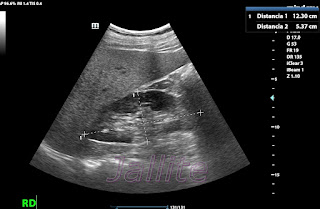Elastografia Shear Wave en la Esteatosis Hepatica
Mostramos a continuacion uno de los primeros casos del estudio de la elastografia de ondas de choque o de cizallamiento (shear Wear elastography) realizado por nosotros. Esto nos sirve para valorar el grado de fibrosis hepatica en pacientes con diagnostico de esteatosis hepatica.Esta valoracion es de suma importancia para tener un dato confiable del avance fibrotico de esta afeccion,es sumamente objetivo y se aleja de la subjetividad inherente a los estudios sonograficos habituales de los grados que solemos asignar a la infiltracion grasa del higado.Con el dejamos atras la subjetividad del estudio de la esteatosis hepatica y pasamos a ponderar el grado preciso de tejido fibrotico que infiltra el tejido hepatico. Se considera que la elastografia shear wave hepatica tiene un margen de error mucho menor que el fibroscan tradicional y por supuesto , con un precio bastante menor.
Paciente masculino de 54 años de edad con diabetes familiar ,muestra una Shear Wear Elastography con una mediana de 7.56 KPa, dentro de un rango de fibrosis hepatica leve, por estar ligeramente por encima de la mediana considerada normal ( 5.10 +/- 1.02 kPa).
Con este analisis objetivo podemos pronosticar que este paciente tiene un riesgo bajo de progresion de su enfermedad por estar por debajo de 8.0 KPa en la actualidad.
Shear Wave Elastography in Hepatic Steatosis
We show below one of the first cases of the study of shock wave or shear elastography (shear Wear elastography) carried out by us. This helps us to assess the degree of hepatic fibrosis in patients diagnosed with hepatic steatosis. This assessment is extremely important to have reliable data on the fibrotic progression of this condition, it is extremely objective and moves away from the subjectivity inherent in sonographic studies. of the degrees that we usually assign to the fatty infiltration of the liver. With it, we leave behind the subjectivity of the analysis of hepatic steatosis and we proceed to ponder the precise degree of fibrotic tissue that infiltrates the hepatic tissue. Liver shear wave elastography is considered to have a much lower margin of error than traditional fibroscan and, of course, at a much lower price.
A 54-year-old male patient with familial diabetes shows a Shear Wear Elastography with a median of 7.56 KPa, within a range of mild liver fibrosis, slightly above the median considered normal (5.10 +/- 1.02 kPa).
With this objective analysis, we can predict that this patient has a low risk of progression of his disease because he is currently below 8.0 KPa.





Comentarios